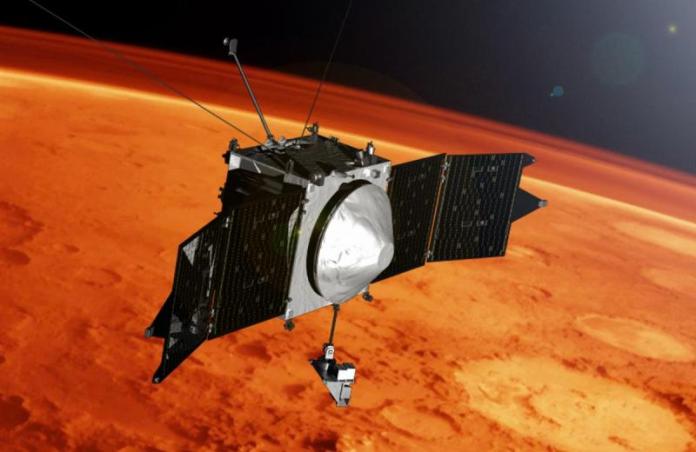MAVEN (Mars Atmosphere and Volatile EvolutioN) is NASA’s first mission dedicated to studying the red planet’s upper atmosphere. It was launched on 18 November 18, 2013.

MAVEN Spacecraft in Mars Orbit
MAVEN is a NASA space probe designed to study the Martian atmosphere while orbiting planet Mars. MAVEN will be inserted on September 22, 2014 in Mars Orbit.
Specs:
Launch Mass 2,454 kg (5,410 lb)
Length: 11.4 meters (37.5 feet)
Purpose
The aim of MAVEN Mission is:
1. To determine how the Martian atmosphere and water (presumed to be substantial earlier) were lost over time.
2. To learn how the modern Mars works in detail.
3. To understand how the atmosphere is lost to space.
4. To understand how Mars may have lost a magnetic field.

5,4,3,2,1 – we have lift off Atlas V with MAVEN MARS mission
About
MAVEN stand for Mars Atmosphere and Volatile Evolution.
The principal investigator for the spacecraft is Bruce Jakosky of the Laboratory for Atmospheric and Space Physics at the University of Colorado at Boulder.
MAVEN is managed by NASA’s Goddard Space Flight Center.
History
* MAVEN was formally approved in October 2010 at a cost to NASA of $438 million excluding launch services and a telecommunications relay package.

STUNNING PICTURE…Atlas V with MAVEN aboard during launch preparations – morning 18 November 2013.
* AeroSpaceGuide.net MAVEN Launch Coverage Started at 5.50pm GMT on Monday 18 November 2013.
* MAVEN was launched on an Atlas V rocket on 18 November, 2013.

Is it a bird, is a plane or is it a rocket?
* November 2015: Speed of Solar Wind Stripping Martian Atmosphere
MAVEN mission identified the process that appears to have played a key role in the transition of the Martian climate from an early, warm and wet environment that might have supported surface life to the cold, arid planet Mars is today.
MAVEN data has enabled scientists to determine the rate at which the Martian atmosphere currently is losing gas to space via stripping by the solar wind. The erosion of Mars’ atmosphere increases significantly during solar storms.
MAVEN examined how solar wind and ultraviolet light strip gas from of the top of the Mars’s atmosphere. The loss is experienced in three different regions of the Red Planet: down the ‘tail’ where the solar wind flows behind Mars, above the Martian poles in a ‘polar plume’ and from an extended cloud of gas surrounding Mars. Scientists determined that almost 75 percent of the escaping ions come from the tail region and nearly 25 percent are from the plume region, with just a minor contribution from the extended cloud.
MAVEN measurements indicate that the solar wind strips away gas at a rate of about 100 grams (about 1/4 pound) every second.
* October 2016: NASA reported escaping water on Mars does not always go gently into space.
MAVEN spacecraft revealed the ups and downs of hydrogen escape and therefore water loss. The escape rate peaked when Mars was at its closest point to the sun and dropped off when the planet was farthest from the sun. The rate of loss varied dramatically overall, with 10 times more hydrogen escaping at the maximum.
Hydrogen in Mars’ upper atmosphere comes from water vapor in the lower atmosphere. An atmospheric water molecule can be broken apart by sunlight, releasing the two hydrogen atoms from the oxygen atom that they had been bound to. Several processes at work in Mars’ upper atmosphere may then act on the hydrogen, leading to its escape.
* NASA’s MAVEN Spacecraft Shrinking its Mars Orbit to Prepare for Mars 2020 Rover.
Did you know?
* The previous USA mission was the Mars Science Laboratory aka Curiosity.
* MAVEN is the first planetary mission managed by NASA’s Goddard Space Flight Center.

Maven Logo
Books:
Mars: The Inside Story of the Red Planet by Heather Couper and Nigel Henbest
from Amazon.co.uk
The Smithsonian Book of Mars by Joseph M. Boyce
from Amazon.com, Amazon.co.uk
Mapping Mars: Science, Imagination, and the Birth of a World by Oliver Morton
from Amazon.com, Amazon.co.uk
MAVEN Links
Mars Atmosphere and Volatile Evolution Mission – MAVEN: NASA
NASA’s MAVEN Mission Observes Ups and Downs of Water Escape from Mars: NASA – October 19, 2016.
NASA Mission Reveals Speed of Solar Wind Stripping Martian Atmosphere: November 5, 2015.
Taking Flight at Cape Canaveral: The Atlas V rocket carrying the Maven spacecraft sits at Cape Canaveral, Florida, prior to its expected launch. Birds in foreground. Photograph: NASA/Bill Ingalls/EPA – November 19, 2013.
Any comments or suggestions, click on Contact Info.









You must be logged in to post a comment.